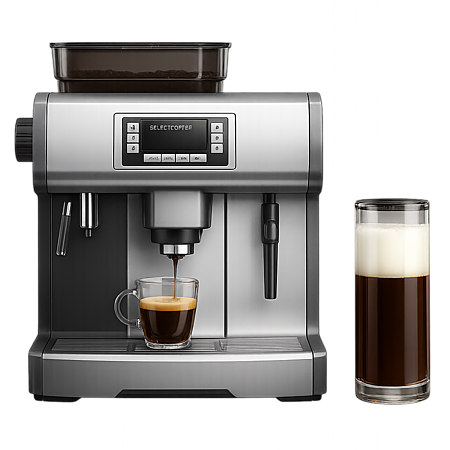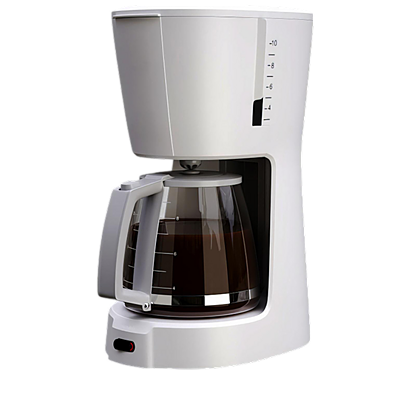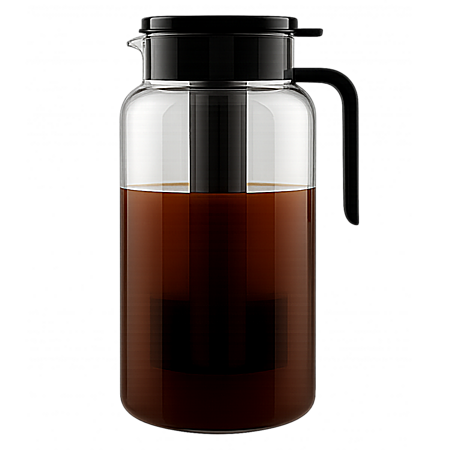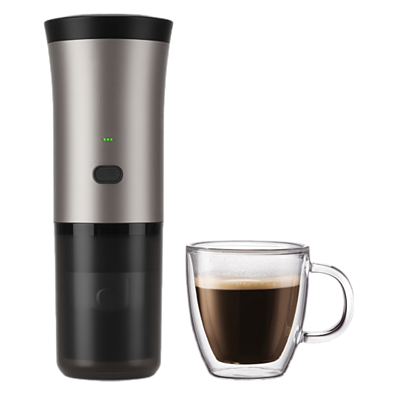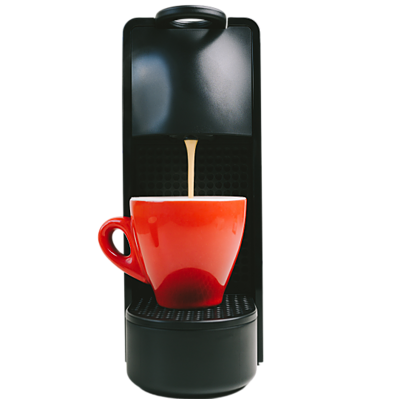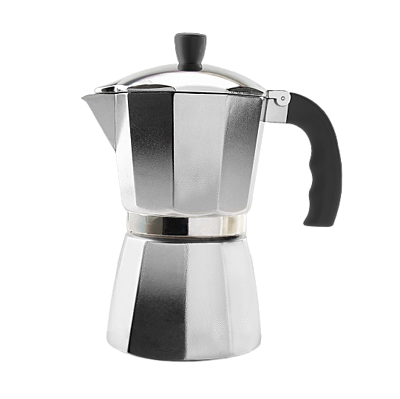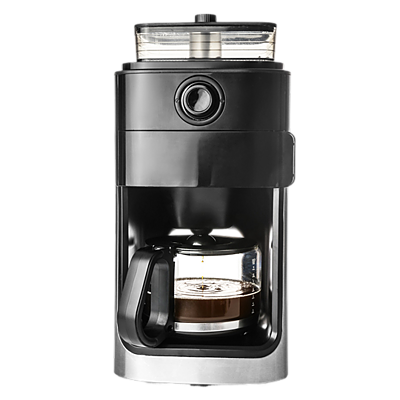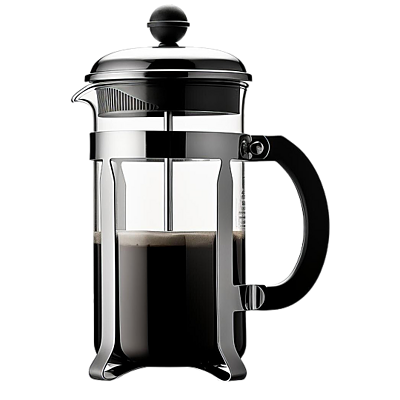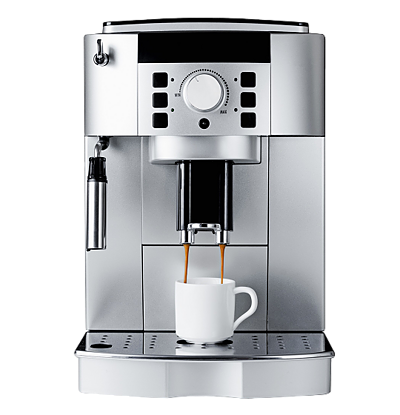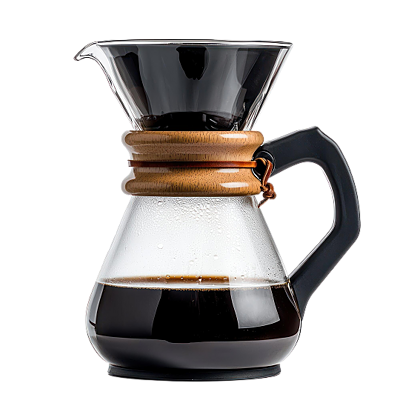Las cafeteras de molido y preparación ofrecen una práctica solución integral al combinar un molinillo y una cafetera de goteo en una sola máquina. Esta configuración permite moler granos frescos justo antes de preparar el café, lo que ayuda a conservar el sabor y el aroma, factores clave para obtener una mejor taza de café en casa.
En esta guía, desglosaremos las características clave que debes buscar, desde los tipos de molinillos y la capacidad de preparación hasta la facilidad de limpieza, para que puedas encontrar el modelo adecuado que se ajuste a tus necesidades, preferencias de sabor y presupuesto.
Cómo comprar una cafetera de molido y preparación: características clave a considerar
Tipo de molinillo
El tipo de molinillo incorporado en tu cafetera influye considerablemente tanto en el sabor como en la consistencia. La cafetera de molido y preparación suele utilizar un molinillo de cuchillas o de muelas, y la diferencia entre ambos es significativa.
Los molinillos de cuchillas utilizan una cuchilla metálica giratoria para picar los granos. Suelen encontrarse en modelos más económicos y son rápidos y sencillos, pero producen granos de molienda irregular. Esta inconsistencia puede provocar una extracción desequilibrada: algunos granos quedan sobreextraídos y amargos, otros subextraídos y débiles.
Los molinillos de muelas, por otro lado, trituran los granos entre dos superficies abrasivas (planas o cónicas). Ofrecen un tamaño de partícula uniforme, lo que mejora la claridad y consistencia del sabor. Además, permiten ajustar el tamaño de la molienda, lo que proporciona mayor control sobre la intensidad del café y la extracción. Son la opción preferida de los amantes del café y son comunes en los modelos de gama media y alta.
Si buscas un café con mejor sabor y más equilibrado, así como la posibilidad de ajustar la preparación, una máquina con molinillo de muelas es la mejor inversión. Para un uso básico o para quienes beben café de forma ocasional, un molinillo de cuchillas puede ser suficiente, pero ten en cuenta que sacrificarás la consistencia.
Ajustes de molienda
Los ajustes de molienda determinan el grosor del café molido, lo que influye directamente en la extracción y el sabor. Contar con ajustes de molienda en una cafetera de molido y preparación te permite adaptar el tamaño de la molienda a tu estilo de preparación y a los granos de café que prefieras.
Una molienda más fina extrae el café más rápido y puede producir una taza más fuerte e intensa, pero también puede causar amargor o sobreextracción si es demasiado fina. Una molienda más gruesa extrae el café más lentamente, lo que resulta en un sabor más ligero y un cuerpo más suave. La mayoría de las cafeteras de goteo funcionan mejor con una molienda media, pero la opción de ajustar el grado de molienda te permite experimentar y encontrar el equilibrio ideal.
Busca una cafetera de molido y preparación con múltiples niveles de molienda; algunas ofrecen de 5 a 10 niveles o más. Los modelos de gama alta pueden incluir un control preciso que te permite ajustar la molienda según tus preferencias de intensidad o grano. Los diales o controles digitales fáciles de usar facilitan y permiten cambiar el tamaño de la molienda de forma repetitiva.
Tipo de jarra
El tipo de jarra influye tanto en la duración del café caliente como en la comodidad de servirlo. La mayoría de las cafeteras de molido y preparación vienen con jarra de vidrio o térmica, cada una con sus propias ventajas.
Las jarras de vidrio son la opción tradicional y permiten ver cuánto café queda de un vistazo. Suelen colocarse sobre una placa calefactora que mantiene el café caliente, pero puede causar un sabor a quemado o amargo si se dejan sobre ella demasiado tiempo. Las jarras de vidrio suelen ser más ligeras y fáciles de limpiar, pero menos eficaces para mantener la temperatura a lo largo del tiempo.
Las jarras térmicas tienen doble pared y están aisladas, generalmente son de acero inoxidable, diseñadas para mantener el café caliente durante horas sin necesidad de una placa calefactora. Esto conserva el sabor durante más tiempo y es ideal si prefieres tomar el café lentamente o preparar varias tazas a lo largo del día. Las jarras térmicas suelen ser más pesadas y caras, pero ofrecen mejor retención de calor y son más fáciles de transportar.
Considera tu rutina y preferencias al elegir un tipo de jarra. Si tomas café rápidamente o prefieres ver los niveles de café, una jarra de vidrio podría ser la mejor opción. Si deseas mantener el café caliente y como recién hecho durante más tiempo sin recalentarlo, una jarra térmica es la opción más inteligente.
Intensidad y personalización de la infusión
Los controles de intensidad de café te permiten ajustar la proporción de café y agua o el tiempo de preparación según tus preferencias. La mayoría de las cafeteras ofrecen múltiples configuraciones de intensidad, lo que te permite elegir entre sabores suaves, medios o intensos sin tener que medir manualmente el café molido ni el agua.
Los ajustes personalizables permiten ajustar la cantidad de café, el tamaño de la molienda o la duración de la preparación. Algunos modelos avanzados incluso permiten ajustar con precisión los parámetros de extracción para un control más preciso. Esta flexibilidad es útil si prefieres un café más intenso por la mañana y más ligero al final del día, o si preparas café para diferentes bebedores con preferencias diversas.
Busca diales, botones o controles digitales fáciles de usar que indiquen claramente los niveles de intensidad. Las máquinas que combinan el ajuste de intensidad con el control del tamaño de molienda ofrecen aún mayor versatilidad, permitiéndote personalizar tanto la intensidad del sabor como la textura.
Funciones programables
Las funciones programables añaden comodidad y consistencia a tu experiencia de molido y preparación. Busca máquinas con temporizador de 24 horas, que te permite programar con antelación la hora de preparación. Esto significa que puedes despertarte o llegar a casa y disfrutar de un café recién molido y preparado sin esfuerzo.
Además de los temporizadores básicos, algunos modelos incluyen opciones para programar la intensidad del café, el tamaño de la molienda y la cantidad de tazas, lo que te brinda mayor control sobre cada ciclo de preparación. Las máquinas avanzadas también pueden incluir recordatorios automáticos de limpieza, ajustes de preinfusión y temperaturas de preparación ajustables.
Las interfaces intuitivas, ya sean pantallas digitales o botones sencillos, facilitan la programación de tus preferencias. Algunos modelos de gama alta incluso se conectan a aplicaciones para smartphones, lo que te permite empezar a preparar café a distancia o guardar perfiles de café personalizados.
Dosificador de derivación
Un dosificador de derivación te permite agregar café premolido directamente a tu cafetera de molido y preparación, sin pasar por el molinillo integrado. Esta función es útil si deseas usar café de especialidad, descafeinado o mezclas premolidas sin pasarlas por el molinillo cada vez.
Con un dosificador de derivación, puedes cambiar fácilmente entre café en grano y molido, lo que te ofrece mayor flexibilidad. También es práctico si tu molinillo no funciona correctamente o si quieres ahorrar tiempo en las mañanas ajetreadas.
No todos los modelos con sistema de molido y preparación incluyen un dosificador de derivación, así que, si te gusta la variedad o usas café premolido ocasionalmente, busca esta función al comprar. Añade comodidad sin sacrificar la posibilidad de moler granos frescos cuando quieras.
Tipos de cafetera de molido y preparación: elige según el caso de uso
La elección de la cafetera de molido y preparación adecuada depende del nivel de comodidad y control que desees obtener.
Molinillo de cuchillas + máquina de goteo
Ideal para: principiantes con presupuesto limitado
Pros: asequible, sencilla y compacta
Contras: molienda inconsistente, control limitado del sabor
Una opción para empezar si estás empezando a preparar café recién molido, pero no quieres invertir demasiado
Sistemas de molinillo de muelas + jarra de vidrio
Ideal para: bebedores de café caseros que valoran la consistencia
Pros: mejor sabor, funciones programables, precio medio
Contras: molienda más ruidosa, la jarra de vidrio necesita una placa calefactora
Cafeteras cotidianas de confianza para hogares ocupados o parejas que desean calidad y comodidad.
Sistemas de molinillo de muelas + jarra térmica
Ideal para: personas que beben lentamente o preparan café durante el día
Pros: mantiene el café caliente durante más tiempo, no necesita placa calefactora
Contras: un poco más voluminosa, a menudo más cara
Perfecta para preparar una sola vez y beber durante la mañana sin sacrificar el sabor.
Máquinas inteligentes de molido y preparación de café
Ideal para: amantes del café entusiastas de la tecnología
Pros: control mediante app, funciones avanzadas de temperatura y extracción
Contras: cara, curva de aprendizaje más pronunciada
Ideal para usuarios que desean una experiencia estilo cafetería con precisión personalizable.
Funciones avanzadas que vale la pena considerar
- Selector de intensidad: Selector de intensidad: te permite seleccionar la duración del tiempo de preparación y la cantidad de granos molidos
- Control de temperatura: permite controlar la temperatura para una extracción precisa, especialmente en tostados más ligeros
- Filtro de agua incorporado: filtra las impurezas del agua que pueden afectar al sabor y la longevidad de la máquina
- Tolva de granos con sello: proporciona un área de almacenamiento sellada para los granos de café con el fin de mantenerlos frescos y ayudar a prevenir la oxidación
- Opción de molido: permite el uso de café premolido si se desea
- Modo de preparación silencioso: funcionamiento más silencioso para hogares con personas que se levantan temprano
- Alertas de autolimpieza o descalcificación: facilita el mantenimiento de la máquina
- Tamaños de preparación duales: algunos modelos tienen la opción de preparar una cafetera completa o una porción individual
Desglose del presupuesto: qué esperar
Las cafeteras que muelen y preparan café tienen una variedad de precios, lo que refleja las diferencias en la calidad de fabricación, el tipo de molinillo y las características.
- Menos de 85 €: los modelos básicos suelen usar molinillos de cuchillas y ofrecen funciones básicas de preparación. Son económicos, pero pueden ofrecer una molienda menos consistente y menos opciones programables. Ideales para uso ocasional o principiantes.
- 86 €-164 €: las máquinas de gama media suelen incluir molinillos de muelas, múltiples ajustes de molienda y temporizadores programables. Combinan calidad, personalización y durabilidad para el uso diario.
- Más de 164 €: los modelos premium ofrecen molinillos de alta calidad, programación avanzada, control preciso de temperatura y materiales de primera calidad como jarras de acero inoxidable. Estas máquinas ofrecen una calidad de café superior y una fiabilidad duradera, ideales para los amantes del café.
¿Qué cafetera de molido y preparación se adapta a tu rutina?
Casi todo el mundo entra en una de estas categorías. ¿En cuál de ellas te encuentras?
- ¿Buscas simplicidad? Elige un modelo con un solo toque y controles de intensidad preestablecidos
- ¿Te gusta dormir hasta tarde? Elige un modelo programable con inicio automático para que el café esté listo cuando tú quieras
- ¿Tienes un hogar con gustos diferentes? Busca opciones de potencia y volumen personalizados, además de un dosificador de derivación
- ¿Bebes lentamente a lo largo del día? Elige un modelo con jarra térmica para evitar que el café se queme
- ¿Tienes poco espacio? Opta por una cafetera compacta con menos piezas extraíbles
- ¿Buscas una personalización al estilo de una cafetería? Elige modelos premium con ajustes de molienda, control de temperatura e integración con la app.
¿La cafetera de molido y preparación es adecuada para ti?
Si te atrae la idea de un café recién hecho sin complicaciones, una cafetera de molido y preparación es ideal para ti. Es perfecta para quienes desean un café más fresco sin usar dos máquinas separadas (molinillo y cafetera). Pero si te encanta experimentar con métodos de vertido o espresso manual, quizás prefieras un equipo independiente. Para el resto, es frescura y comodidad en un solo paquete.
¿Necesitas ayuda para comparar sistemas de molienda y preparación o para explorar otros métodos? Consulta mi guía de compra de cafeteras para obtener toda la información necesaria.


